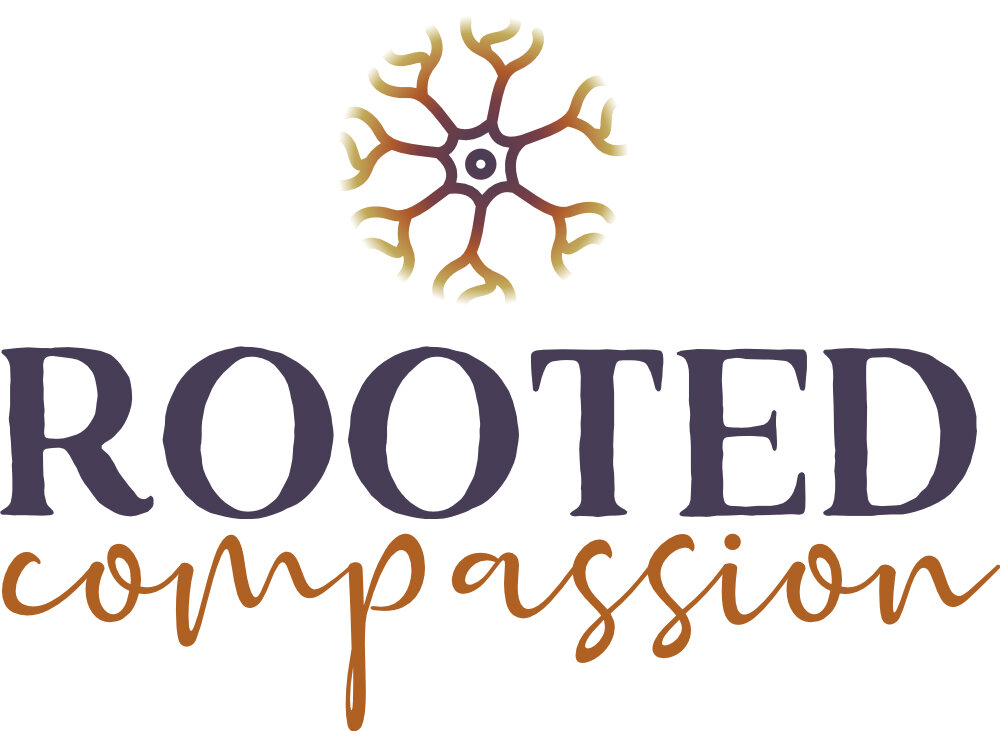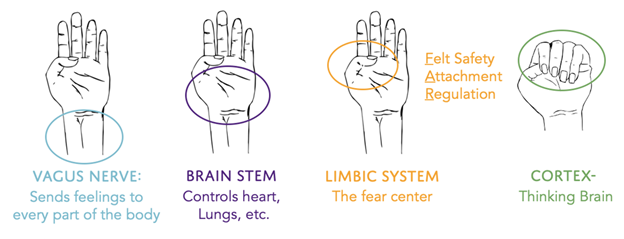Cincinnati Therapist Explains the Hand Model of the Brain: Understanding your Emotional Responses
Dr. Dan Siegel offers a powerful image known as the "hand model of the brain" to explain the nervous system and the brain's response to trauma or emotional discomfort, particularly in relation to behavior and emotions. This model is an excellent tool for individuals to understand their “triggers” and stress.
Begin by imagining the hand in a loose fist with the thumb tucked under the fingers. The fingers represent the cortex, the tucked-in thumb represents the limbic area and subcortical structures, the palm represents the brainstem, and the wrist represents the vagus nerve and spinal cord. The limbic area (thumb) has direct connections to both the cortex and brainstem.
The vagus nerve and spinal cord communicate directly from the body and bring messages to the brain, first landing in the brainstem. As part of the autonomic nervous system, the vagus nerve modulates our social connections. For those with complex trauma or who are neurodivergent, an overactive vagus nerve can overwhelm the brain with messages.
The brainstem (palm) takes information from the body and regulates systems for our well-being, including digestion, breathing, bladder and bowel control, and heart rate. It acts as a gatekeeper, signaling other parts of the brain when one is not feeling safe, either physically or emotionally. When the brainstem receives signals that the nervous system is uncomfortable or unsafe, it alerts the limbic system through body sensations.
The limbic system (thumb) regulates felt safety, attachment, and emotional regulation. It assists with memory and, along with the hippocampus and amygdala, modulates our attachment to others. Its primary job is to manage the fight, flight, or freeze response. Our brain has no conscious control over its activation. The limbic system communicates through sensations and pictures.
The cortex (fingers) creates “maps” of the world through visual and auditory input, forming associations in thought. It modulates executive functions such as planning, organizing, and problem-solving and aids in empathy and compassion. According to Dr. Siegel, the cortex is not fully formed until the age of 25. It communicates in pictures and language.
When our nervous system is activated due to experiences perceived as physically or emotionally unsafe, the brainstem receives that information and alerts the limbic system. In Siegel’s model, this results in our thinking brain going “offline.” Using the hand model, the straightening of the fingers indicates that our brain has gone “offline,” limiting access to its functions. In these moments, the detachment between the limbic system and cortex impairs logical thinking, leading to behaviors driven by emotion and preventing thoughtful responses.
Dr. Siegel presents this as an all-or-nothing response: when we are “triggered” or activated by a lack of safety, our entire cortex is not available to us. However, in my work, I have observed that most people unconsciously develop behavioral survival skills that allow them to continue functioning at some level. In the hand model, this is represented by some fingers straightening, providing partial access to the thinking brain. Additionally, everyone has some level of safety or confidence that allows them to manage daily life. For instance, one might think, “I can get the kids ready for school, drop them off, and get to work, but if one thing goes wrong at work, I am going to lose it.” Most people prefer to manage their daily tasks without feeling this way.
Our autonomic nervous system continuously and primarily unconsciously assesses our safety. By learning about this function, we can begin to recognize when we may go offline, whether in intense ways where we can’t think through something or in less intense ways that still impact daily functioning. Recognizing and responding to our experiences of being “offline” is key to positive emotional regulation and felt safety.
If you are interested in exploring the power of counseling, whether individual or as a couple, Rooted Compassion, has immediate openings!
The Rooted Compassion team is made up of a group of counselors who have a variety of specialties in order to best serve our clients. We recognize that every person has his/her own personal and unique life experiences and that one modality will not work for every client. Listed below is a summary of our counselors’ specialties at Rooted Compassion:
Polyvagal Theory/Nervous System Focused Therapy
Trauma Responsive Care Techniques
Grief Counseling
Somatic Focused Counseling
Eye Movement Desensitization and Reprocessing, EMDR
Dialectical Behavior Therapy
Mindfulness-Based Practices
Acceptance and Commitment Therapy
Drama Therapy/Expressive Arts
If you are interested in learning more about what Rooted Compassion is all about, please contact us today, look through our website, or find us on Instagram and Facebook.
Rooted Compassion Counseling is Ohio’s leading practice for trauma therapy through the lens of the nervous system. Our focus is to walk alongside clients as they heal from depression, anxiety, trauma, grief and/or loss. If you or someone you know are seeking to explore and build an inner sense of calm and safety, please contact us today. We would love to help you to find a counselor and counseling techniques that will guide you on your mental health journey to healing.



